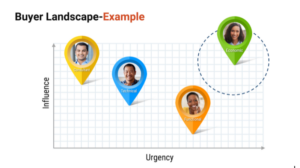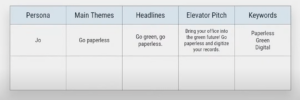The product marketing role has moved from simply communicating a message to crafting the message to fit specific buyer personas. This means product marketers are taking on the role of a strategic partner with sales and the executive team to help guide decisions.
How did we discover this shift in product marketing?
During the 20th Annual Pragmatic Institute Product Survey, we asked successful product marketers at high-growth companies what they were doing that contributed to their success.
Here’s what we learned:
- 86% of the respondents to our survey said they were responsible for understanding the customer’s buying process.
- 80% said they had ownership of buyer personas.
- 70% said they had ownership of user personas.
- 57% of the respondents spent time on the market definition, sizing and segmentation.
- 33 hours a month on average is dedicated to the creation of both sales collateral and sales tools.
With this increase in responsibility for buyers and the buying process, it’s essential for product marketers to have the right tools in their belts in order to drive revenue success. In this article, we’re going to talk about how to approach creating buyer personas strategically and utilize the messaging matrix.
Speak to the Persona’s Role
Building personas means investing time asking questions like, “What are the challenges customers have and what are their goals?” and “Where could our solutions meet their needs?”
Your buyer might fit a particular persona in a specific industry, but what is their role in the buying process?
It could be that a buyer is one of many decision-makers, especially in the B2B space. It’s not enough to just think of one person.
We have to think about how to craft a message that speaks to the persona not just as a buyer but also to their role.
For example, the economic buyer might be looking for the cheapest solution in the market. They might also need to understand why your solution is at a certain price or if there are bulk discounts. They want to know all the ways they can adjust the end price they’ll pay.
The functional buyer might be the user of the product. They might want to understand the features and how the product is going to solve the day-to-day problems they experience.
The technical buyer may have no interest in understanding the price (unless their budget is affected) or the details of the features. However, they do want to know about interoperability and ensure that the product will integrate nicely with systems already in place at their organization.
Use Familiar Language
When we’re thinking about how we craft our message, we have to use the language for that role and the vernacular that is familiar to them.
A Quick Example:
A marketing group was tasked with creating a message that’d build interest and awareness about area food pantries. Now, if you’re familiar with this particular industry, you’d know that a food bank is a distribution facility that sends inventory to food pantries.
This marketing company started crafting a message about local food pantries in a neighborhood. However, the residents in the area were more familiar with the word “food bank.”
So there was a disconnect between the correct terminology and the word that your market would recognize and use.
So, when you’re crafting messaging you should:
- Know your buyer
- Understand their role in the buying process
- Be able to speak their language
That’s challenging, especially if there are multiple buyers.
So, we wanted to put together a tool: the messaging matrix.
Many departments (Marcom, sales and customer success) can all play a role in message development, so this internal tool ensures alignment.
While the messaging matrix seems like a pretty simplistic tool, it’s powerful because it’s designed to help you think strategically about crafting a message to a particular person in a specific role based on what they’re doing for that sales cycle.
When you’re marketing to someone you don’t know, then you’re just talking at them. When you can build a communication channel, then you can begin to connect, which is how you’ll get the sale.
Positioning is sometimes thought of as the one document to rule them all. However, depending on who owns the document in the organization, it might have the facts but it doesn’t have the language that marketing communication or sales can use to ensure consistency.
This document helps the go-to-market team because they are either going to cut and paste the language you’ve crafted or make their own.
So, what you want to do is give them the language that resonates and have them use it. That is the ideal solution.
The message matrix is the strategy piece for marcomms that’ll guide all the messaging that will eventually go out into the world.
We are excited to announce the launch of a new version of Market, which includes the Message Matrix tool and others. This course helps you gain a thorough understanding of your buyers and how they like to buy so you can build product marketing strategies that deliver results. >> Learn More
Author
-

The Pragmatic Editorial Team comprises a diverse team of writers, researchers, and subject matter experts. We are trained to share Pragmatic Institute’s insights and useful information to guide product, data, and design professionals on their career development journeys. Pragmatic Institute is the global leader in Product, Data, and Design training and certification programs for working professionals. Since 1993, we’ve issued over 250,000 product management and product marketing certifications to professionals at companies around the globe. For questions or inquiries, please contact [email protected].










